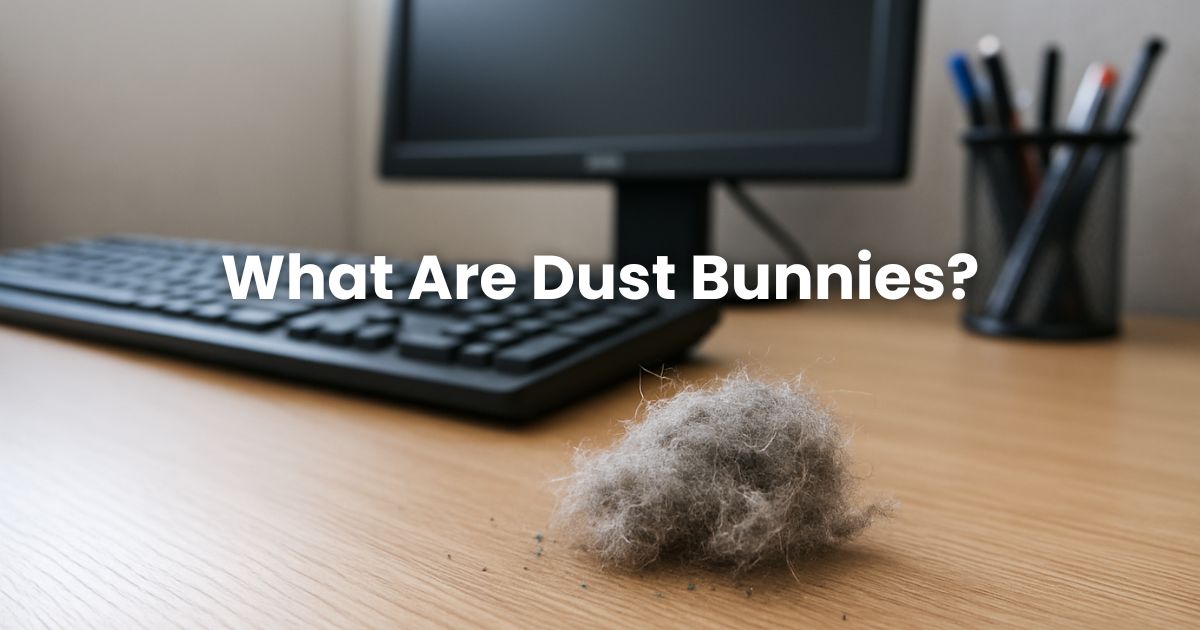What Are Dust Bunnies?

If you’ve ever noticed small clumps of dust lurking beneath desks or behind filing cabinets, you’ve likely encountered dust bunnies. But what are dust bunnies, really? And more importantly—how can they impact the cleanliness and health of your workspace?
Let’s explore what they’re made of, why they form, and how routine professional office cleaning can stop them from multiplying in your building.
The Anatomy of a Dust Bunny
Dust bunnies are small clumps of dust, debris, and fibers that are held together by static electricity. In office environments, they’re typically made up of:
- Hair and lint from employees and visitors
- Dead skin cells, which shed naturally and add to indoor dust
- Dust mites, microscopic insects that feed on organic matter
- Spider webs, which help trap airborne particles
- Paper dust and carpet fibers, especially in high-traffic work areas
- Dust particles from HVAC vents or ceiling fans
Because they’re light and fibrous, dust bunnies tend to collect in areas with low air circulation—like under office furniture, behind cabinets, or along baseboards.
Why Dust Bunnies Are a Problem in Offices
While they may seem harmless, dust bunnies can cause several problems in a professional environment:
- Health issues: They can harbor allergens like dust mites and pollen, contributing to asthma or respiratory irritation, especially for employees with sensitivities.
- Clogged electronics: Dust accumulation around computers, printers, or HVAC systems can reduce airflow and cause overheating.
- Perception of neglect: Visible dust buildup signals a lack of attention to detail and can reflect poorly on your company’s professionalism.

Where Do Dust Bunnies Hide in the Office?
These dusty clusters often gather in hard-to-reach or often-overlooked places:
- Under desks and chairs
- Along the edges of cubicle walls and partitions
- Behind printers, copiers, and file cabinets
- Around vents, baseboards, and corners
- Under and behind breakroom appliances
Because most employees don’t clean these areas themselves, dust bunnies can easily build up without regular attention.
How to Get Rid of Dust Bunnies in a Commercial Space
Eliminating dust bunnies starts with a consistent cleaning strategy. Here’s how professionals clean and prevent them in workspaces:
1. High-Touch and Low-Traffic Areas
Routine dusting of light switches, door handles, and shelving helps remove particles before they gather. Corners and under-furniture spaces should be vacuumed or dusted weekly.
2. Proper Equipment
Commercial-grade vacuums with HEPA filters trap dust particles and allergens, rather than just moving them around. Microfiber cloths trap debris and reduce static electricity buildup.
3. HVAC and Ventilation Maintenance
Ceiling fans, vents, and filters should be cleaned regularly. Otherwise, they become a source of circulating dust that helps form new bunnies.
4. Scheduled Deep Cleans
Dust bunnies form over time. A monthly or quarterly deep cleaning—especially under furniture and behind equipment—helps eliminate buildup before it becomes a problem.
5. Partner with Professionals
Cleaning companies like Buildingstars offer customized commercial cleaning services designed for office environments. From daily upkeep to deep cleaning plans, our trained teams target every hiding spot to help you maintain a clean, healthy, and professional workspace.
Final Thoughts
So, what are dust bunnies? They’re more than just a quirky name for rogue dust clumps—they’re a signal that your cleaning routine might be missing key areas. In offices, their presence can affect air quality, equipment performance, and overall impressions. By investing in regular professional cleaning, businesses can keep dust bunnies—and the problems they bring—out of sight and out of mind.
